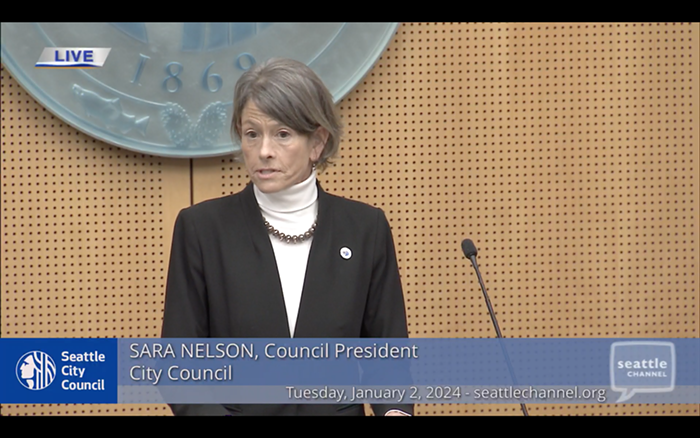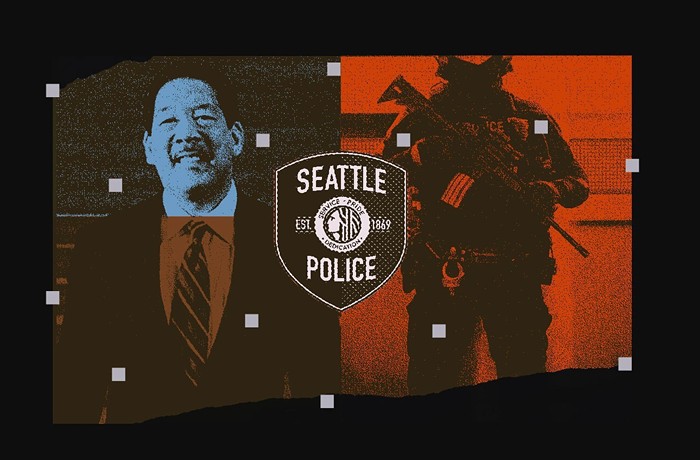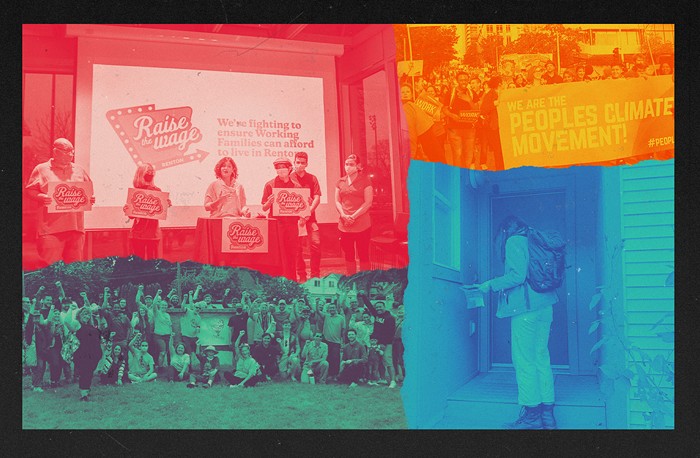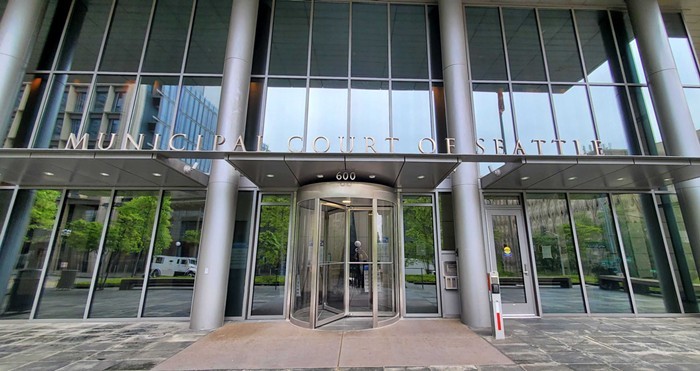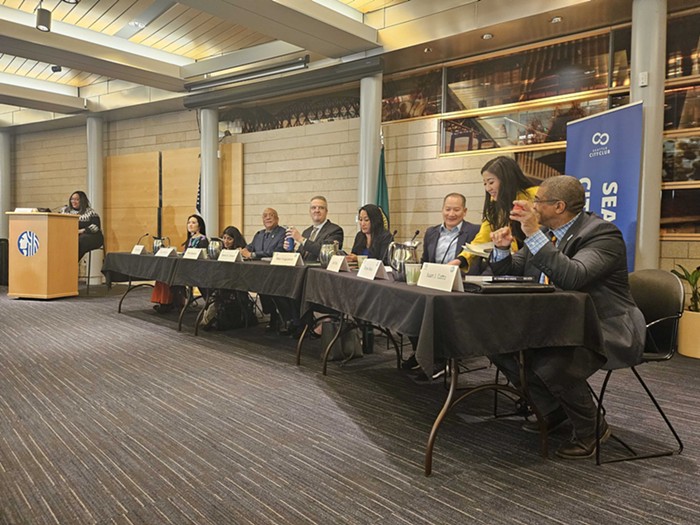
After nearly half a year of new leadership on homelessness, people are still sleeping outside, and neither the “Seattle Is Dying” crowd nor the housing-first crowd appear to have much to crow about.
Seattle's limited supply of emergency shelter and permanent housing continue to make it difficult for social workers to find places for people to sleep inside, and the City's near daily encampment sweeps have made traumatic displacement the only reliable form of outreach, with social workers rarely able to find shelter for unhoused people who do not live in high-profile encampments.
Mayor Bruce Harrell borrowed his plan for homelessness from the defunct Compassion Seattle initiative. As part of that plan, he vowed to “identify” 2,000 units of emergency shelter in his first year. But right now, only he knows if he’s on track to make good on that promise; after 100 days in power, last month his office refused to tell The Seattle Times how many units the administration had identified. I emailed his office to ask again, and so far I've received no answer.
But Harrell is not the only one calling the shots. When the City decided to hand over its contracts with homelessness service providers to the King County Regional Homelessness Authority (KCRHA) in 2021, KCRHA CEO Marc Dones assumed their position as head honcho of homelessness and signaled a more progressive, housing-first approach to solving the crisis.
Though still in its infancy, the KCRHA has not quite lived up to that spirit advocates recognized in Dones, a spirit they articulated in a Seattle Times panel held before the agency got off the ground: “There is the idea that we will ‘services’ our way out of a problem that is fundamentally economic. And it simply cannot be done. There is no amount of service that is a house,” Dones said.
And yet, earlier this year Dones and Harrell came together to promote a billionaire-backed initiative called Partnership for Zero, a new service that would set up a team of “peer navigators” to help people navigate the system into housing. During a media roundtable about the initiative, KCRHA panelists said the peer navigators would not have any special access to shelter, temporary or otherwise. As Zaneta Reid, a lived-experience leader at KCRHA, put it, the authority does not have any exclusive path to get people inside, but they do have “hopes and dreams.”
While outreach workers from around the city say they could always use more hands, they warn of a huge supply-and-demand issue for shelter space and for permanent housing that leaves them as resource-connectors with few resources to connect people to.
“Not having the resources when somebody's reaching out for help is heartbreaking. It’s something that will chip away at you daily working this job,” said CoLEAD Entry & Care Manager Nichole Alexander.

According to the last Point-in-Time count in 2020, almost 12,000 King County residents lived unhoused. The KCRHA put that number at more than 40,000. With under 3,000 emergency shelter options reported in the last quarter of 2021, outreach workers have been feeling the pinch.
Though experts agree that we only need to build more homes to solve the homelessness crisis, social workers agree that emergency shelter remains critically important.
“Temporary shelter builds that bridge. It's extremely difficult to get someone all the right documentation to get into housing when they are living in a tent, against the elements. You get them their ID, and then it gets rained on, or they get swept and everything gets thrown away and they start at ground-zero all over again,” Alexander said.
Service providers from the Low Income Housing Institute, REACH, CoLEAD, and other organizations agree that the best way to find shelter is to get swept into it – and the Mayor’s office has ordered plenty of sweeps. “If you are at a prioritized site, that’s how you get shelter. Really, people outside of a prioritized site don't get shelter,” said Karen Salinas, director of outreach at REACH.
But outreach workers who refer people to shelter say the City doesn’t even have enough space to accommodate the Mayor’s recent sweep frenzy.
Because of the Supreme Court's Martin v. Boise ruling, cities cannot criminalize camping outside when people have no other place to go. For that reason, the City prioritizes bed space for victims of forced displacement. However, some of those beds don’t meet the needs of some unhoused people, and so they have to reject them. Meanwhile, some people who want those beds arrive at the camps after the City has already made its shelter offers, and so those people miss out.
But even if the City had a perfect record of offering an adequate bed to everyone living in an encampment, Publicola reported that only around 36% of people who received shelter referrals from the HOPE Team actually showed up to those shelters from September 2021 to March 2022, which suggests that the City’s reported number of referrals does not equal the number of people who actually find a place sleep inside after a sweep.
Outside the context of sweeps, the City’s HOPE team, which is in charge of encampment outreach response, is even less likely to find someone a spot.
“We can always put in referrals [to the HOPE team], but we never hear back. It's a really, really rudimentary system for the level of complicated coordination that it takes,” Salinas said.
Here’s how that really really rudimentary system operates on an average day: Each morning, social workers who make shelter referrals text a number that gives them the count of available shelter beds based on capacity the night before. To take one example, Alexander at CoLEAD said that on Wednesday, May 18, the City only had four beds for women, two beds for men, one bed for a person of any gender, and four tiny homes. With a sweep planned for that morning, she said she might as well not bother trying to find shelter for a person sleeping anywhere outside that particular encampment on that day.
If she did bother, though, she would have had to “nominate” that person for shelter in an industry-wide Microsoft Teams message thread, and then a member of the HOPE team would ultimately approve or reject that nomination. Alexander said an outreach worker and the unsheltered person can wait hours to hear back from the City about an available bed. When she worked outreach at the Waterfront with REACH, she could make a referral at 8 am and not hear back until 2 pm – if she heard back at all, that is. The HOPE team will only call the social worker if it can place the unsheltered person, so sometimes silence is the only response, an issue that Salinas attributed to the team’s lack of staffing.
If the HOPE team did have a shelter spot to offer, though, a team member would alert the outreach worker, who would then give the unsheltered person the appropriate stack of paperwork the shelter required for entry. Then the unhoused person would have to haul that paperwork to the site, and make it there on time before it closed for the evening.
To work around the uncertainty of the HOPE team’s set-aside shelter beds, Charlene Mitchell, the interim director at Compass Housing Alliance, said that some nonprofits such as the Urban League and the Matt Talbot Center buy beds from shelters that the City does not own. The going rate for those is about $3 a night, Mitchell said.
The KCRHA seems to understand the outreach workers’ point of view on the shelter supply issue. As PubliCola reported, the agency’s board will vote this week to ask the City and the County to double its budget, which would allow the authority to add over 500 shelter spaces.
While the agency has repeatedly said that adding temporary shelter won't solve the problem of homelessness, its current approach will still require those spaces in some capacity.
“There will always be a role for emergency shelter, but it should be utilized more like the hospital emergency room as a temporary place where people can stabilize and then move to a more permanent option,” said the spokesperson for the KCRHA in an email.
To further clarify the authority’s plan, the spokesperson sent an infographic from WeAreIn, an advocacy group that works closely with the KCRHA, illustrating the ratio of temporary shelter to permanent housing both at present and in a more ideal future.
Right now, WeAreIn argues the City invests too much in increasing shelter capacity, despite the supply-and-demand issues noted by outreach workers. WeAreIn asserts that the City should reduce investments into emergency shelters that politicians like Harrell advocate for, and instead scale up investments into housing, as Dones would have it.

The homelessness nonprofit sector in general also tends to prefer this sort of housing-first approach. But if shelter opens up once in a blue moon, then a provider securing a permanent housing option for a homeless person is like seeing a blue moon, getting struck by lightning, and winning the lottery on a leap day.
For example, two spots at a new Plymouth Housing building opened up in May, and REACH had the opportunity to pitch the people they work with. With roughly 70 case managers at REACH alone, all with a caseload of about 30 people, Salinas called the cutthroat pitching process “the Hunger Games of Housing.”
CoLEAD is often better situated to move people from encampments into temporary shelter and then into permanent housing, said Alexander. When the City swept City Hall Park last summer, CoLEAD brought 31 of those swept residents into its program. As of this May, 22 of those people were still in the program and had a housing plan. CoLEAD booted the others out of the program for behavioral issues and lack of engagement, and one person died. Though CoLEAD specializes in permanent housing, the program operates on a small scale, but that could grow as more housing becomes available.
This year, lawmakers in Olympia dropped a historic $300 million investment to acquire properties to use for housing and shelters. The Governor’s office said the session’s investments into an affordable housing fund and rapid housing acquisition would yield “approximately 3,890 additional housing units that will help more people transition into safe, stable housing situations.” That’s not nothing, but that’s a statewide number, and, as I mentioned earlier, the KCRHA says 40,000 people experienced homelessness in 2020 in King County alone.
Meanwhile, statewide, in 2019 the National Low Income Housing coalition estimated that Washington faced a 200,000-unit deficit of homes that people can reasonably afford. To prevent people from needing to rely on the overburdened shelter system in the first place, experts say the state will need to close that gap.
According to Gregg Colburn, the author of Homelessness Is a Housing Problem, Seattle is at a crossroads. The City has propped up some shelter space and some affordable housing, but neither to scale, so leaders like Harrell and Dones have to decide whether to invest in temporary shelter to warehouse unhoused people or to invest in making Seattle denser and more affordable.
Colburn said the City needs a “both-and,” approach: Scale up both temporary shelter and permanent housing.
“We look at outreach workers, policy makers, all sorts of people and say, ‘you gotta fix this,’ but they don’t have the resources to do so,” Colburn said. “We can’t get people out of the streets if there’s nowhere to put them.”

